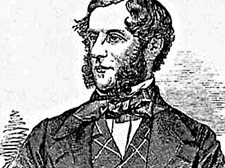|
|
 |
| |
 John Sadleir John Sadleir |
So who’s the greatest swindler of them all?
Such were the crimes of John Sadleir MP, that he was the model for no less than three of Victorian English fiction’s greatest financial criminals, writes Gerald Isaaman
HE lies in an unmarked grave in Highgate Cemetery, unrecognised, unloved and forgotten. Yet when John Sadleir committed suicide on Hampstead Heath in February 1856, he was the Victorian equivalent of American fraudster Bernie Madoff.
In fact, he was probably even more infamous in this country, thanks to his dazzling career as a world banker and investor, Liberal MP and cabinet minister ignominiously thrown out of the House of Commons.
And it was on the scandalous past of the boy born in Tipperary in 1813 that Charles Dickens created his swindler Merdle in Little Dorrit, just a year after Sadleir’s death in 1856, and he was also the model for Melmotte in Anthony Trollope’s The Way We Live Now, two novels dramatised for TV in recent times.
In another, now-lost novel, Samuel Warren’s Ten Thousand a Year, he popped up as Swindle O’Gibbet MP.
The Bankers’ Magazine described Sadleir as “one of the greatest, if not the greatest swindler that this or any other country has produced when the full extent of his frauds was revealed to be £1.5million, probably £100million in today’s values.
That may not be as great as Madoff’s admitted crimes in fleecing the rich and famous, now handcuffed to prison to await his fate, but The Times summarily denounced Sadleir as “a national calamity” who had precipitated total panic and hysteria in the banking system on a then unrivalled level.
Indeed, JC Prichard, a senior physician at the Bristol Infirmary, published a Treatise on Insanity and Disorders of the Mind in which he proposed a new term of “moral insanity”, which he defined as a “morbid perversion of the natural feelings, affections, inclinations, temper, habits, moral dispositions and natural impulses without any remarkable disorder of the hallucination”.
Writing in the March issue of Prospect magazine, novelist Julian Gough, a relative of Sadleir, declares that his career was “a stick of dynamite – short and explosive”, adding: “He inherited a small Tipperary bank, set off to London to make his fortune, was elected to Westminster in 1847, while still in is early thirties, and was £1.5million in debt by January 1856. Not bad going for a Tipperary lad. Some of this debt came from buying 3,000 acres of land from Ireland’s Encumbered Estates Court, some from loaning money to the Duke of Buckingham, but most came from reckless speculation on the London stock exchange using money borrowed from his own bank.”
Technological change was the frenzy of the 1840s and 50s when railway mania infected everyone. Honour and ethics disappeared in the lust for making a fortune.
So Sadleir speculated far afield, in continental railways and mining explorations. In one day alone he lost £120,000 speculating in sugar. So he began to forge, steal and lie his way out of trouble, even seeking the hand of several wealthy Catholic heiresses to save himself, alas without success.
The Tipperary Bank collapsed when the extent of his activities became known, together with some of the companies he defrauded, imploding all round the world, ranging from the Royal Swedish Railway Company to Carson’s Creek Gold Mining Company.
“Looked at from this sour point in the history of banking, John Sadleir’s crime was being a century and a half ahead of his time,” says Julian Gough.
“Over-borrowing against worthless assets in order to over-trade in products you don’t understand, not caring if it brings the bank down as long as you can make off with the profits, became an honoured and envied way of life.
“There are tens of thousands of John Sadleirs walking the streets of London and New York, free and rich, their money legally embezzled from insolvent institutions.”
But only one of them, John Sadleir himself, recognised his disastrous guilt, took a small cream jug to Hampstead Heath and, in a quiet spot behind Jack Straw’s Castle, drank its lethal mixture of prussic acid, opium pellets and just a touch of sugar.
|
 |
|
 |
 |
|
 |
|
 John Sadleir
John Sadleir 
